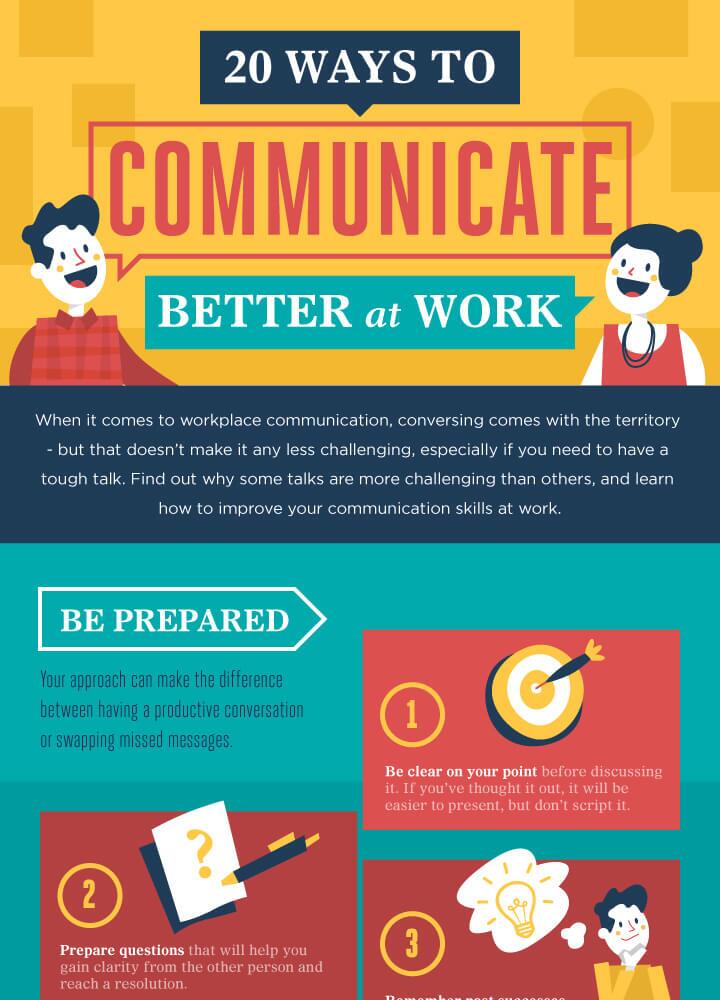Effective communication is a cornerstone of success in any workplace. Whether you’re working in a small team or a large organization, the ability to communicate effectively can make all the difference in achieving your goals. Effective communication not only allows for clear understanding and seamless collaboration among team members, but it also improves employee morale, increases productivity, and enhances job satisfaction.
Jump To Section
What is effective communication in the workplace?
Effective communication in the workplace refers to the clear and efficient exchange of information, ideas, and feedback among employees, teams, and management. It involves open and honest interactions that foster collaboration and understanding. When communication is effective, it helps create a positive work environment and greatly contributes to the overall success of the organization.

Benefits of effective communication in the workplace
One of the most significant benefits of effective communication in the workplace is the mitigation of conflicts. Clear and open communication channels allow for the early identification and resolution of potential conflicts. This leads to a harmonious work environment where misunderstandings and disputes are minimal.
Increased employee engagement
Effective communication promotes employee engagement by making employees feel valued, heard, and involved in the decision-making process. When employees are engaged, they are more committed to their work and are motivated to contribute to the organization’s success.
Improved productivity
When communication is clear and streamlined, employees have a better understanding of their roles and responsibilities. This clarity leads to improved productivity as employees can focus on their tasks without confusion or misunderstandings. Additionally, effective communication enhances coordination and collaboration between teams, further enhancing overall productivity.
Improved client relations
Effective communication is crucial for maintaining strong client relations. Clear communication ensures that client expectations are properly understood and met. It enables employees to effectively address client inquiries, concerns, and feedback promptly, leading to enhanced client satisfaction and loyalty.
Healthy workplace culture
Effective communication is a key factor in establishing a healthy workplace culture. It fosters transparency, trust, and collaboration among employees. When employees feel comfortable expressing their opinions and concerns, it creates a positive work environment where everyone feels valued and supported.
Improved direction for employees
When communication is effective, employees have a clear understanding of the organization’s goals, expectations, and strategic direction. This clarity provides employees with a sense of purpose and direction, enabling them to align their work and efforts accordingly.
Boosted employee job satisfaction
Effective communication positively impacts employee job satisfaction. Employees who feel heard and have open lines of communication with their supervisors are more likely to be satisfied with their work. Regular feedback and recognition, facilitated through effective communication channels, contribute to increased job satisfaction and retention.
Increased innovation
Effective communication encourages the free flow of ideas and fosters a culture of innovation. When employees feel comfortable sharing their ideas and perspectives, it leads to creative problem-solving and continuous improvement within the organization.
Strengthened team building
Clear and open communication promotes strong team bonds and collaboration. It allows team members to understand their roles within the team and creates an environment where ideas and feedback are shared openly. Effective communication also helps resolve conflicts quickly and encourages cooperation, strengthening the overall dynamics of the team.
Improved public impression
Effective communication has a direct impact on an organization’s public image. Clear communication with external stakeholders, such as clients, partners, and the media, promotes a positive reputation. It demonstrates professionalism, trustworthiness, and the ability to effectively deliver messages to various audiences, enhancing the organization’s public perception.
“Unlock the power of effective communication to foster collaboration, boost productivity, and create a positive work environment. Discover the key benefits that can transform your workplace. #CommunicationIsKey #WorkplaceSuccess”
Tips for effective workplace communication
While the benefits of effective communication in the workplace are clear, it is important to implement strategies and best practices to foster successful communication. Here are some tips to enhance workplace communication:

Image courtesy of www.td.org via

Practice active listening
Active listening involves giving your full attention to the speaker, seeking to understand their message, and providing appropriate responses. Avoid interruptions and distractions, and show empathy and understanding during conversations. Active listening is a communication skill that requires actively engaging with the speaker and demonstrating genuine interest in what they are saying. It involves several key elements, including:
- Giving full attention: When practicing active listening, focus your attention solely on the speaker. Avoid multitasking or engaging in distracting activities, such as checking your phone or thinking about other matters.
- Seeking to understand: Actively listen to the speaker’s words, tone, and body language to gain a comprehensive understanding of their message. Pay attention to both the content and the underlying emotions they convey.
- Providing appropriate responses: Responding appropriately shows that you are actively engaged in the conversation. You can demonstrate this by providing verbal and nonverbal cues such as nodding, making eye contact, or uttering brief affirmations like “I see” or “I understand.”
- Avoiding interruptions: Allow the speaker to express themselves fully without interrupting or imposing your own thoughts and opinions. Wait for natural pauses in their speech before asking clarifying questions or sharing your perspective.
- Minimizing distractions: Find a suitable environment for the conversation where external distractions are minimized. Turn off or silence any devices that may interrupt the flow of the conversation.
- Showing empathy and understanding: Try to put yourself in the speaker’s shoes and understand their perspective. Respond with empathy and validate their feelings, acknowledging their experiences and demonstrating that you genuinely care about their thoughts and emotions.
Active listening is a crucial skill in building strong relationships, fostering effective communication, and promoting mutual understanding. By actively listening, you create an atmosphere of trust and respect, which can lead to more meaningful and productive conversations.
Provide positive feedback
Regularly provide constructive and positive feedback to employees. Acknowledge their accomplishments, highlight areas for improvement, and offer support and guidance. This not only enhances communication but also boosts employee morale. Regularly providing constructive and positive feedback to employees is crucial for their growth and development. Acknowledging their accomplishments, no matter how big or small, shows them that their efforts are recognized and valued. This boosts their motivation and encourages them to continue performing well.
However, it is equally important to highlight areas for improvement. Constructive feedback helps employees identify areas where they can enhance their skills and performance. It should be specific, actionable, and given in a supportive manner. Instead of focusing solely on the problem, also offer guidance and support to help the employee overcome any challenges.
Open and frequent communication is key when providing feedback. Schedule regular check-ins or performance reviews, and encourage employees to share their thoughts and concerns as well. This promotes a culture of collaboration and trust, which leads to improved communication and teamwork.
In addition to feedback sessions, consider implementing a system that allows employees to provide feedback to each other as well. Peer feedback can offer different perspectives and insights, and it creates a culture of continuous improvement.
Finally, remember to celebrate milestones and achievements along the way. Recognize employees for their hard work and dedication, whether it’s through verbal appreciation, rewards, or other forms of recognition. This not only shows gratitude but also reinforces positive behavior and encourages others to strive for excellence.
By regularly providing constructive and positive feedback, you can create a positive work environment, boost employee morale, and ultimately drive personal and organizational growth.

Have face-to-face meetings
While digital communication tools are convenient, face-to-face meetings are valuable for building rapport and establishing clear communication. Schedule regular in-person meetings to discuss important matters, provide updates, and foster personal connections among team members. Here are a few reasons why face-to-face meetings are valuable for building rapport and establishing clear communication:
- Non-verbal communication: During face-to-face meetings, we can observe facial expressions, body language, and other non-verbal cues that help us better understand the message being conveyed. This can prevent misinterpretation and promote effective communication.
- Immediate feedback: In-person meetings allow for real-time feedback and clarification. Team members can ask questions and provide immediate responses, ensuring everyone is on the same page and reducing misunderstandings.
- Relationship building: Personal connections are essential for fostering trust and teamwork. Face-to-face meetings provide an opportunity for team members to interact on a more personal level, strengthening their relationships and enhancing collaboration.
- Brainstorming and creativity: Face-to-face meetings often spark creativity and generate new ideas. The energy and enthusiasm that come from being physically present can inspire team members to think outside the box and contribute ideas more freely.
- Building consensus: Certain decisions or discussions require consensus or agreement among team members. Face-to-face meetings allow for open dialogue and negotiation, making it easier to arrive at a mutual understanding and reach a consensus.
To make the most of face-to-face meetings:
- Set a regular schedule: Having consistent in-person meetings, whether weekly, bi-weekly, or monthly, helps establish a routine and allows for better planning.
- Prepare an agenda: Share an agenda before the meeting, outlining the topics to be discussed and any materials or information required. This ensures that everyone comes prepared and maximizes the time spent together.
- Encourage participation: Create an inclusive environment where all team members feel comfortable contributing and sharing their thoughts. Encourage active participation by asking open-ended questions and providing space for discussion.
- Follow up with meeting minutes: After the meeting, share minutes or a summary of the discussion, decisions made, and action items assigned. This helps reinforce communication and keeps everyone accountable.
While digital communication tools offer convenience and efficiency, face-to-face meetings remain vital for effective communication, rapport building, and team bonding. By scheduling regular in-person meetings and leveraging the benefits they provide, organizations can foster a strong and cohesive team dynamic.
Wrapping Up
Effective communication is the backbone of a successful workplace. It fosters collaboration, minimizes conflicts, enhances productivity, and improves employee satisfaction. By implementing the tips mentioned above and prioritizing clear and open communication, organizations can reap the numerous benefits of effective workplace communication.


